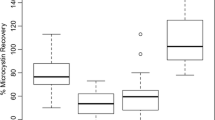Abstract
An ELISA has been developed for the quantification of metallothioneins (MT) in liver from different species of fish. MT has also been quantified by RIA and DPP to allow a comparison between the methods. The immunoassays were carried out with a polyclonal antibody raised against perch (Perca fluviatilis) hepatic MT [1] which cross-reacted with hepatic MT from dab (Limanda limanda), lemon-dab (Microstomus kitt), and cod (Gadus morhua). The ELISA was more sensitive for the detection of MT from the flatfish than RIA and DPP. The detection limits of MT by immunoassays were lower for fish caught in the field than for Cd-injected fish. The immunoreactivity differed between MT from different fish species, more markedly between fish MT and rabbit MT. MT values determined by the three methods have been compared and showed that the results were similar and significantly correlated. Advantages and disadvantages of the ELISA are discussed in relation to the other methods.
Similar content being viewed by others
References
Hogstrand C, Haux C (1990) Toxicol Appl Pharmacol 103:56–65
Hamer DH (1986) Ann Rev Biochem 55:913–951
Kägi JHR, Kogima Y (1987) In: 52 Kägi JHR, Kogima Y (eds) Experentia Suppl. Metallothionein II. Birkhauser, Basel, pp 25–61
Kägi JHR, Schäffer A (1988) Biochem 27:8509–8515
Brady FO (1982) Elsevier, Biomed. Press, Amsterdam New York, pp 143–145
Webb M, Cain K (1982) Biochem 31:137–142
Hogstrand C, Haux C (1991) Comp Biochem Physiol 100C:137–141
Kito H, Tazawa T, Ose Y, Sato T, Ishikawa T (1982) Comp Biochem Physiol 73C:129–134
Shears MA, Fletcher GI (1984) Can J Zool 62:2211–2220
Roch M, McCarter JA, Matheson AT, Clarck MJR, Olafson RW (1982) Can J Fish Aquat Sci 39:1596–1601
Hogstrand C, Lithner G, Haux C (1991) Pharmacol Toxicol 68:492–501
Olafson RW, Thompson JAJ (1974) Mar Biol 28:83–86
Bouquegneau JM, Gerday C, Disteche A (1975) Febs Lett 55:173–177
Lehman LD, Klaassen CD (1986) Anal Biochem 153:305–314
Eaton DL, Toal BF (1982) Toxicol Appl Pharmacol 66:134–142
Berthet B (1989) Oceanis 15:401–409
Wofford HW, Thomas P (1984) Mar Env Res 14:119–137
Olafson RW, Sim RG (1979) Anal Biochem 100:343–351
Thompson JAJ, Cosson RP (1984) Mar Env Res 11:137–152
Vander Mallie RJ, Garvey JS (1979) J Biol Chem 254:8416–8421
Garvey JS, Vander Mallie RJ, Chang CC (1982) In: Langore JJ, Van Vunakis H (eds) Methods in enzymology, Vol 84. Academic Press, New York, pp 121–138
Mehra RJ, Bremner I (1983) Biochem J 213:459–465
Thomas DG, Linton H, Garvey JS (1986) J Immun Meth 89:239–247
Roesijadi G, Unger ME, Morris JE (1988) Can J Fish Aquat Sci 45:1257–1263
Chatterjee A, Maiti IB (1987) Molec Cell Biochem 78:55–64
Hylland K, Haux C, Hogstrand C, Sletten K, Andersen RA (1994) Fish Physiol Biochem 13:81–91
Norey CG, Lees WE, Darke BM, Stark JM, Baker TS, Cryer A, Kay J (1990) Comp Biochem Physiol 95B:597–601
George S, Burgess D, Leaver M, Frerichs N (1992) Fish Physiol Biochem 10:43–54
Duquesne S, Richard A (1994) Mar Biol 119:461–470
Olafson RW, Olsson PE (1991) Meth Enzym 205:205–213
Hogstrand C, Wilson RW, Polgar D, Wood CM (1994) J Exp Biol 186:55–73
Hylland K, Haux C, Hogstrand C (1992) Mar Ecol Progr Ser 91:89–96
Hogstrand C, Haux C (1990) J Exp Mar Biol Ecol 138:69–84
Hogstrand C, Olsson PE, Haux C (1989) Mar Env Res 28:183–186
Ghaffar A, Aggett PJ, Bremner I (1989) In: Johnson, Fenwick (eds) Royal Society of Chemistry and Special Publications, Sothgate, pp 74–76
Olsson PE, Haux C (1986) Aquat Toxicol 9:231–242
Hogstrand C, Haux C (1992) Anal Biochem 200:388–392
Chatterjee A. Maiti IB (1990) Molec Cell Biochem 94:175–181
Winge DR, Garvey JS (1983) Proc Natl Acad Sci USA 80:2472–2476
Kay J, Cryer A, Darke BM, Kille P, Lees WE, Norey CG, Marshall SJ (1991) Int J Biochem 23:1–5
Author information
Authors and Affiliations
Rights and permissions
About this article
Cite this article
Duquesne, S., Janquin, M.A. & Hogstrand, C. Quantification of fish hepatic metallothioneins, naturally or artificially induced, by ELISA: A comparison with radioimmunoassay and differential pulse polarography. Fresenius J Anal Chem 352, 589–595 (1995). https://doi.org/10.1007/BF00323079
Received:
Revised:
Accepted:
Issue Date:
DOI: https://doi.org/10.1007/BF00323079



